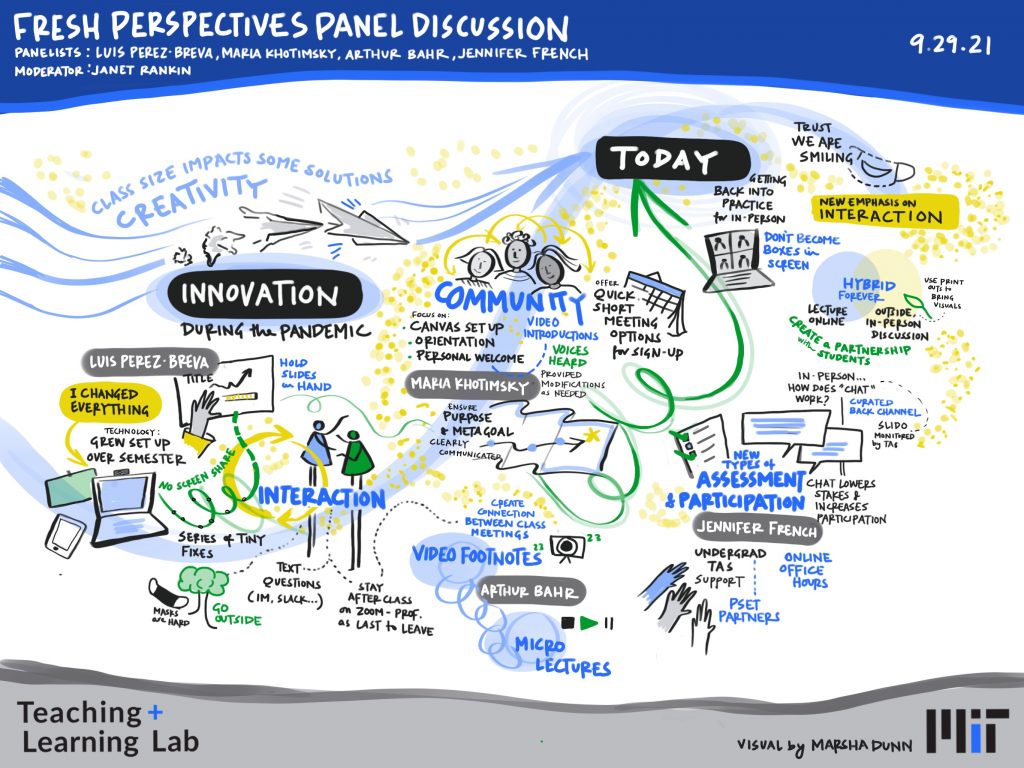Fresh Perspectives from MIT educators (part 1)

On Wednesday, September 29, 2021, the Teaching + Learning Lab hosted the first of two panels featuring faculty and instructors highlighted in the Fresh Perspectives series. Fresh Perspectives is a new ongoing video and audio series launched in 2021 with “Insights from Teaching through a Pandemic,” a set of interviews meant to capture some of the effective teaching techniques adopted during the 2020-2021 school year that could translate well to post-pandemic education.
What strategies did they adopt during the pandemic and what goals did these strategies address?
Dr. Perez-Breva, finding that screen-sharing in Zoom did not work for his teaching style, built a more effective means of showing visuals during remote classes. He set up two mini green screens, one behind his shoulder and one that he could hold in his hand, and he configured them to display whatever content he wished to present. Unlike regular screen-sharing, the set-up allowed him to focus on his students and his students to focus on him, with the visuals appearing only when he wanted students to focus on them. To learn more, see Perez-Breva’s article in the MIT Faculty Newsletter here.
Dr. Khotimsky focused on making Canvas a rich environment for learning and connection, explaining how content mapped to particular learning goals to encourage student metacognition, and requiring video or audio introductions and discussions via Flipgrid so that students could get to know one another.
Professor Bahr used video to keep students engaged with the material between discussions, creating “video footnotes” to respond to student comments and “micro-lectures” to provide valuable historical context.
Dr. French supported several large math classes that had traditionally relied on high-stakes exams as a large part of student grades. During remote teaching, she helped instructors shift the grading to more heavily emphasize homework, small quizzes, and participation (both in class and via online discussion forums). She noted that undergraduate and graduate teaching assistants were critical to shift as they were able to track and grade these many smaller assignments. TAs also monitored the Zoom chat during live lectures, allowing even large classes to function more like recitation sections while traditional lecture content was delivered asynchronously.
In general, the panelists recommended focusing on desired outcomes rather than methods when moving a course from in-person to remote or vice versa. For example, panelists recognized the value of sticking around for a few minutes after an in-person class to answer lingering questions that individual students may have. On Zoom, however, simply staying online does not always achieve the same effect, particularly in larger classes. Dr. Perez-Breva instead encouraged students to text him their questions after class, setting up individual meetings or addressing them at the start of the next class session as appropriate.
How have they adapted those strategies for the 2021-2022 academic year?
Returning to in-person teaching in Fall 2021 has not meant a return to normal, as mask-wearing and the emotional and mental toll of the pandemic continue to impact teaching and learning. Mask-wearing cuts off a channel of communication used for everything from smiling to convey warmth to using mouth positions to teach articulation in a language class. In response, Dr. Khotimsky has continued to teach articulation via Zoom and use Flipgrid videos for introductions so that students can see one another’s smiles. Dr. Perez-Breva, meanwhile, has moved his class outdoors, a change he hopes to keep long after the pandemic ends.
Panelists recognized both pros and cons to trying to recreate the Zoom chat in in-person lectures. Many faculty just want a return to normal, whereas some, like the instructors of 9.01, are adopting tools like Slido. In general, however, experiences using the Zoom chat reminded faculty to build in opportunities for formative assessment and student questions.
The panelists continue to use Zoom in contexts such as office hours, as the convenience can improve student participation. Dr. Khotimsky has also started using an online calendar to allow students to sign up for brief meetings rather than trying to hold office hours at a set time that may not work for everyone. Despite the convenience of Zoom, Professor Bahr emphasizes the importance of getting back into the practice of in-person discussions. Though it may take time to regain in-person communication skills, it is a worthwhile challenge.
Panelists
Director & Lecturer Luis Perez-Breva, 10.807/15.371 MIT Innovation Teams
Senior Lecturer Maria Khotimsky, 21G.613 Russian III (and multiple other subjects)
Associate Professor Arthur Bahr, 21L.705 Major Authors: Chaucer’s Canterbury Tales
Lecturer Jennifer French, Math (supported instructors)
Written by Kate Weishaar

